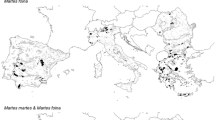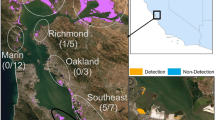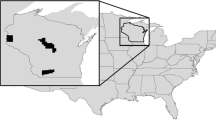Abstract
We investigated the role of patch attributes and context on patch occupancy of the Lower Keys marsh rabbit (Sylvilagus palustris hefneri). The Lower Keys marsh rabbit is a federally endangered lagomorph endemic to the Lower Keys of Florida. The marsh rabbit occurs in subpopulations on patches of high marsh that interact to form a metapopulation. Between March 1991 and July 1993, all known patches of high marsh in the Lower Keys were surveyed for presence or absence of marsh rabbit pellets three times per year. Of the 59 habitat patches, 20 had pellets present during all of the surveys (occupied patches), 22 had pellets present during at least one survey (variable patches), and 17 never had any pellets present (empty). Ten variables were measured at each of the 59 patches; seven of these variables concerned attributes of the patch (food, cover, patch size), and three were patch context variables (distance of patch to other patches, distance of patch to other features). Two discriminant function analysis (DFA) were performed. The first DFA compared empty patches to occupied patches (both variably and consistently occupied). Patch isolation explained the most variation in patch occupancy followed by area. The second DFA compared the variably occupied sites with the consistently occupied sites, and patch attributes variables involving the type and height of vegetation were significant. Management efforts for the Lower Keys marsh rabbit should be aimed at both improving habitat quality and decreasing distance between patches.
Similar content being viewed by others
References
ARC/INFO, Environmental Systems Research Institute, 1990. ARC/info User's Guide, Environmental Systems Research Institute, Redlands, California. 124 p.
Brown, J.H. and Kodric-Brown, A. 1977. Turnover rates in insular biogeography: effects of immigration on extinction. Ecology 58: 445–449.
Canfield, R.H. 1941. Application of the line intercept method in sampling range vegetation. J For 39: 388–394.
Capen, D.E., Fenwich, J.W., Inkley, D.B. and Boynton, A.C. 1986. Multivariate models of songbird habitat in New England forests. In Wildlife 2000: Modeling Habitat Relationships of Terrestrial Vertebrates. pp. 171–176. Edited by J. Verner, M.L. Morrison, and C.J. Ralph. University of Wisconsin Press, Wisconsin.
Chapman, J.A. and Flux, J.E.C. 1990. Introduction and overview of the order Lagomorpha. In Rabbits, Hares and Pikas: Status Survey and Conservation Action Plan. pp. 1–6. Edited by J.A. Chapman and J.E. C. Flux. IUCN, Gland, Switzerland.
Chen, E. and Gerber, J.F. 1990. Climate. In Ecosystems of Florida. pp. 11–34. Edited by R. L. Myers and J.J. Ewel. University of Central Florida Press, Orlando, Florida.
Dobson, F.S. and Jones, W.T. 1985. Multiple causes of dispersal. Am Nat 126: 855–858.
Dunson, W. A. and Lazell, J. D. Jr. 1982. Urinary concentrating capacity of Rattus rattus and other mammals from the Lower Florida Keys. Comp Biochem Physiol: 17–21.
Forys, E. A. 1995. Metapopulations of marsh rabbits: a population viability analysis of the Lower Keys marsh rabbit (Sylvilagus palustris hefneri). Ph.D. Thesis, University of Florida, Gainesville. 244 pp.
Forys, E. A. and Humphrey, S. R. 1996. Spatial organization of the endangered Lower Keys marsh rabbit in a highly fragmented environment. J Mammal 77: 1042–1048.
Forys, E. A. and Humphrey, S. R. 1997. Comparison of 2 methods to estimate density of an endangered lagomorph. JWildl Manage 61: 86–92.
Gilpin, M. E. and Soulé, M. E. 1986. Minimum viable populations: processes of species extinction. In Conservation Biology: The Science of Scarcity and Diversity. pp. 19–34. Edited by M. E. Soulé. Sinauer Associates, Sunderland, Massachusetts.
Gotelli, N. J. 1991. Metapopulation models: The rescue effect, the propagule rain, and the core-satellite hypothesis. Am Nat 138: 768–776.
Gottfried, B. M. 1982. A seasonal analysis of small mammal populations on woodlot islands. Can J Zool 60: 1660–1664.
Gutzwiller, K. J. and Anderson, S. H. 1987. Multiscale associations between cavity-nesting birds and features of Wyoming streamside woodlands. Condor 89: 534–548.
Gutzwiller, K. J. and Anderson, S. H. 1992. Interception of moving organisms: influences of patch shape, size, and orientation on community structure. Landsc Ecol 6: 293–303.
Hanski, I. 1982. Dynamics of regional distribution: the core and satellite species hypothesis. Oikos 38: 210–221.
Hanski, I. 1991. Single species metapopulation systematics: concepts, models and observations. Biol J Linn Soc 42: 17–38.
Hanski, I. and Gilpin, M. 1991. Metapopulation dynamics: Brief history and conceptual domain. Biol J Linn Soc 42: 3–16.
Hanski, I., Kuussaari, M. and Nieminen, M. 1994. Metapopulation structure and migration in the butterfly Melitaea cinxia. Ecology 75: 747–762.
Harrison, S. 1994. Metapopulations and conservation. In Largescale Ecology and Conservation Biology. pp. 89–103. Edited by P. J. Edwards, R. M. May and N. R. Webb. Blackwell Scientific Publications, Oxford, England.
Henderson, M. T., Merriam, G., and Wegner, J. 1985. Patchy environments and species survival: chipmunks in an agricultural mosaic. Biol Con 31: 95–105.
Holt, R. D. 1993. The influence of regional processes on local communities. In Ecological Communities: Historical and Geologic Perspectives. pp. 77–88. Edited by R. E. Ricklefs and D. Schluter. University of Chicago Press, Chicago.
Lachenbruch, P.A. 1975. Discriminant Analysis. Hafner, New York. 128 pp.
Lamberson, R. H., McKelvey, K., Noon, B. R. and Voss, C. 1992. A dynamic analysis of the northern spotted owl viability in a fragmented forest landscape. Con Biol 6: 505–512.
Levins, R. 1970. Extinctions. In Some Mathematical Questions in Biology, Vol. 2. pp. 77–107. Lectures on Mathematics in the Life Sciences. Amer Math Soc, Providence, Rhode Island.
Morrison, D. F. 1976. Multivariate Statistical Methods. Second Edition. McGraw-Hill, New York, New York, 415 pp.
Pietz, P J. and Tester, J. R. 1983. Habitat selection by snowshoe hares in North Central Minnesota. J Wildl Manage 47: 686–696.
SAS. 1988. SAS/STAT User's Guide. Release 6.03 Edition. SAS Institute, Cary, North Carolina, USA.
Shannon, C. E. and Weaver, W. 1949. The Mathematical Theory of Communication. University of Illinois Press, Urbana. 125 pp.
Simonetti, J. A. and Fuentes, E. R. 1982. Microhabitat use by European rabbits (Oryctolagus cuniculus) in Central Chile: Are adult and juvenile patterns the same? Oecologia 54: 55–57.
Tomkins, I. R. 1935. The marsh rabbit: an incomplete life history. J Mammal 16: 201–205.
U.S. Fish and Wildlife Service. 1990. Endangered and threatened wildlife and plants; endangered status for the Lower Keys rabbit and threatened status for the Squirrel Chimney cave shrimp. Federal Register 55(120): 25588–25591.
van Apeldoorn, R. C. Oostenbrink, W. T., van Winden, A. and van der Zee, F. F. 1992. Effects of habitat fragmentation on the bank vole, Clethrionomys glareolus, in a agricultural landscape. Oikos 65: 265–274.
Verboom, J., Lankester, K. and Metz, J. A. J. 1991. Linking local and regional dynamics in stochastic metapopulation models. Biol J Linn Soc 42: 39–55.
Verboom, B. and van Apeldoorn, R. 1990. Effects of habitat fragmentation on the red squirrel, Sciurus vulgaris L. Landsc Ecol 4: 171–176.
Villard, M. A., Freemark, K. and Merriam, G. 1989. Metapopulation theory and neotropical migrant birds in temperate forests: an empirical investigation. In Ecology and Conservation of Neotropical Migrant Landbirds. pp. 474–482. Edited by J. M. Hagen, III and D.W. Johnston. Smithsonian Institution Press, Washington, D.C.
Wood, D. H. 1988. Estimating rabbit density by counting dung pellets. Austral Wildl Res 15: 665–671.
Author information
Authors and Affiliations
Rights and permissions
About this article
Cite this article
Forys, E., Humphrey, S.R. The importance of patch attributes and context to the management and recovery of an endangered lagomorph. Landscape Ecology 14, 177–185 (1999). https://doi.org/10.1023/A:1008013831843
Issue Date:
DOI: https://doi.org/10.1023/A:1008013831843




